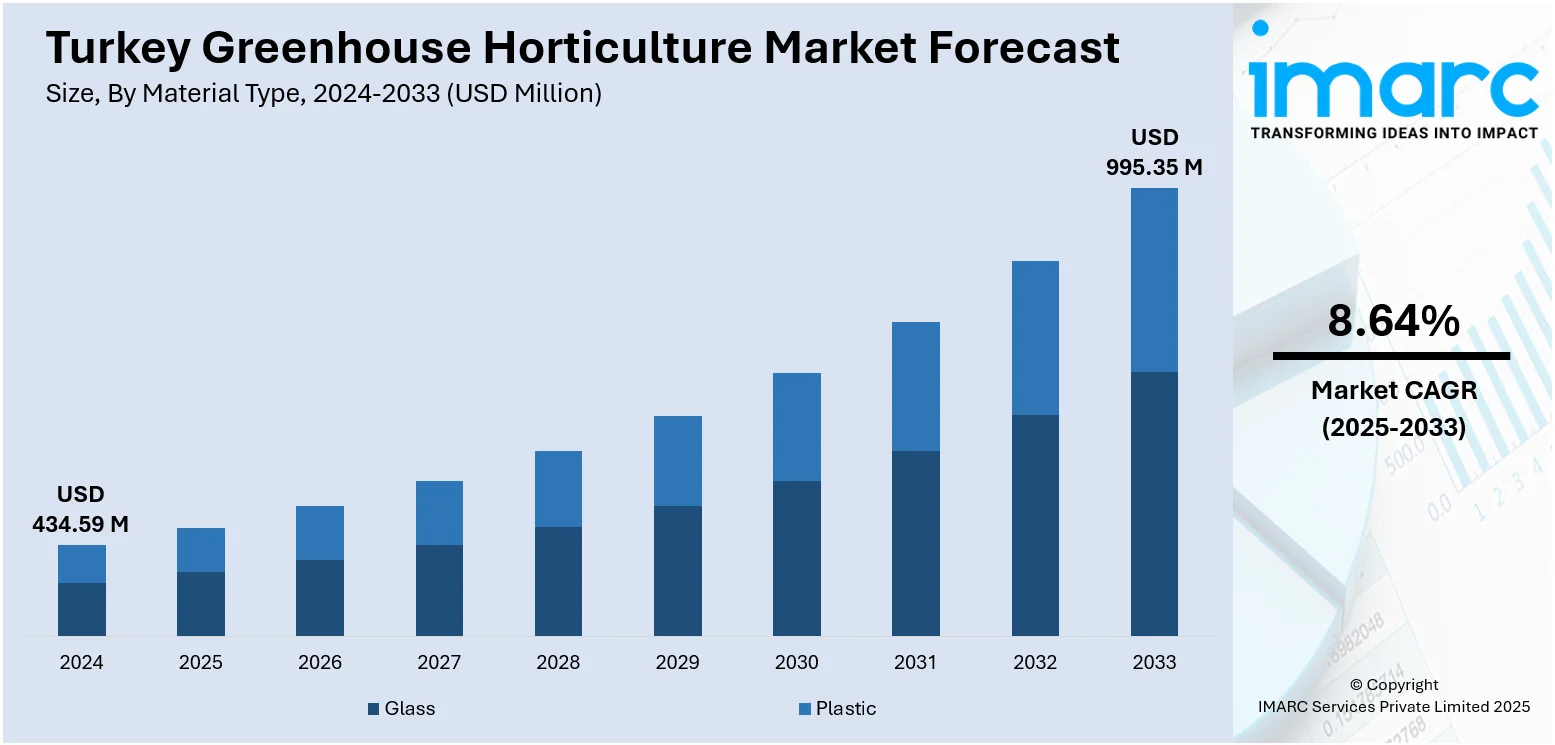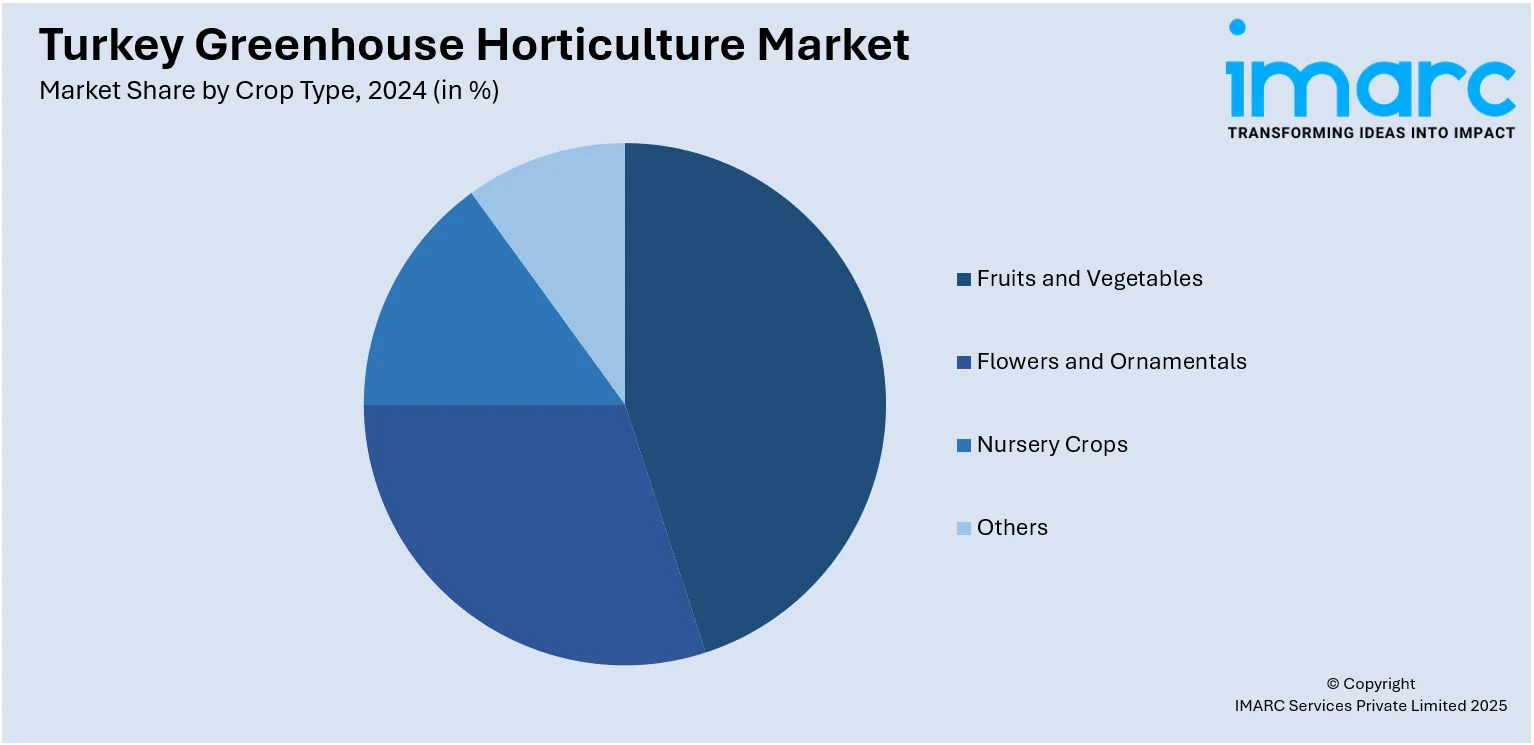
Turkey Greenhouse Horticulture Market Size, Share, Trends and Forecast by Material Type, Crop Type, Technology, and Region, 2025-2033
Turkey Greenhouse Horticulture Market Overview:
The Turkey greenhouse horticulture market size reached USD 434.59 Million in 2024. The market is projected to reach USD 995.35 Million by 2033, exhibiting a growth rate (CAGR) of 8.64% during 2025-2033. The market is driven by increasing demand for fresh fruits and vegetables, due to the country's growing population and improved health consciousness. Additionally, government policies supporting greenhouse facilities, as well as subsidization of advanced agricultural technologies, are also motivating growers to implement sophisticated cultivation practices. In addition to this, supportive climatic conditions and improved export opportunities are also encouraging investments, thus augmenting the Turkey greenhouse horticulture market share.
|
Report Attribute
|
Key Statistics
|
|---|---|
|
Base Year
|
2024
|
|
Forecast Years
|
2025-2033
|
|
Historical Years
|
2019-2024
|
| Market Size in 2024 | USD 434.59 Million |
| Market Forecast in 2033 | USD 995.35 Million |
| Market Growth Rate 2025-2033 | 8.64% |
Turkey Greenhouse Horticulture Market Trends:
Geothermal-Heated Greenhouse Clusters and Organized Zones
Türkiye is expanding geothermal-heated greenhouse clusters that reduce energy costs and allow stable production throughout the year. Projects such as the Agriculture-Based Specialized Greenhouse Organized Industrial Zone in Dikili, İzmir, are designed to bring together multiple high-tech greenhouse units in one location, integrating renewable energy sources like solar, wind, and biogas to further improve efficiency and lower emissions. Notably, the funding allocated by the World Bank for the Agriculture-Based Specialized Greenhouse Organized Industrial Zone in Dikili, İzmir has been increased from USD 30 Million to USD 65 Million. The project envisions the development of 50 high-technology greenhouse units, each spanning at least 25 decares, across a 3 Million m² site, with an annual production target of up to 80,000 tons. The zone will integrate hybrid renewable energy systems, including 169 decares of solar panels alongside wind and biogas facilities, to reduce both carbon emissions and operational costs. In addition to production facilities, the clusters also incorporate post-harvest infrastructure for sorting, packaging, and storage, creating a complete value chain within a single hub.

To get more information on this market, Request Sample
Export-led Growth Anchored in Antalya’s Year-Round Supply
Export demand is increasingly shaping crop choices and production calendars in key greenhouse regions, with Antalya at the forefront. As per industry reports, Türkiye recorded vegetable exports totaling about USD 980 Million in 2024, with Antalya alone contributing USD 441.3 Million. Its ability to supply produce year-round due to the combination of greenhouses and highland fields has made it a central hub for supplying multiple markets across Europe and the Middle East. Antalya accounts for 50% of Türkiye’s greenhouses and glasshouses dedicated to the cultivation of vegetables and leafy greens, according to industry reports. Moreover, export-oriented operations in the region prioritize quality consistency, timely delivery, and compliance with international standards, prompting investments in better climate control, irrigation systems, and post-harvest handling. This export focus is fostering stronger relationships with buyers and encouraging growers to align planting schedules and product varieties with specific market demands. The result is a production system that is more responsive to global market signals and increasingly integrated into international supply chains.
Digitization of Protected Cultivation and Precision Climate Control
Advanced farms are adopting digital tools such as climate sensors, automated irrigation, and remote monitoring systems to improve productivity and crop quality, with smaller farms gradually following this trend. This, in turn, is providing a boost to Turkey greenhouse horticulture market growth. Moreover, in leading greenhouse areas like Antalya, growers are integrating biological pest management with precision fertigation and environmental controls to meet strict quality and safety standards. Besides this, digital systems help maintain optimal conditions even under challenging weather patterns, reducing crop losses and improving marketable yields. These technologies are also enabling better decision-making through real-time data analysis, which supports efficient resource use and consistent production outcomes. Also, the growing availability of ag-tech solutions and support services is making it easier for producers to adopt precision cultivation methods that cater to both domestic and export requirements.
Turkey Greenhouse Horticulture Market Segmentation:
IMARC Group provides an analysis of the key trends in each segment of the market, along with forecasts at the country and regional levels for 2025-2033. Our report has categorized the market based on material type, crop type, and technology.
Material Type Insights:
- Glass
- Plastic
The report has provided a detailed breakup and analysis of the market based on the material type. This includes glass and plastic.
Crop Type Insights:

- Fruits and Vegetables
- Flowers and Ornamentals
- Nursery Crops
- Others
A detailed breakup and analysis of the market based on the crop type have also been provided in the report. This includes fruits and vegetables, flowers and ornamentals, nursery crops, and others.
Technology Insights:
- Heating System
- Cooling System
- Others
A detailed breakup and analysis of the market based on the technology have also been provided in the report. This includes heating system, cooling system, and others.
Regional Insights:
- Marmara
- Central Anatolia
- Mediterranean
- Aegean
- Southeastern Anatolia
- Black Sea
- Eastern Anatolia
The report has also provided a comprehensive analysis of all the major regional markets, which include Marmara, Central Anatolia, Mediterranean, Aegean, Southeastern Anatolia, Black Sea, and Eastern Anatolia.
Competitive Landscape:
The market research report has also provided a comprehensive analysis of the competitive landscape. Competitive analysis such as market structure, key player positioning, top winning strategies, competitive dashboard, and company evaluation quadrant has been covered in the report. Also, detailed profiles of all major companies have been provided.
Turkey Greenhouse Horticulture Market Report Coverage:
| Report Features | Details |
|---|---|
| Base Year of the Analysis | 2024 |
| Historical Period | 2019-2024 |
| Forecast Period | 2025-2033 |
| Units | Million USD |
| Scope of the Report |
Exploration of Historical Trends and Market Outlook, Industry Catalysts and Challenges, Segment-Wise Historical and Future Market Assessment:
|
| Material Types Covered | Glass, Plastic |
| Crop Types Covered | Fruits and Vegetables, Flowers and Ornamentals, Nursery Crops, Others |
| Technologies Covered | Heating System, Cooling System, Others |
| Regions Covered | Marmara, Central Anatolia, Mediterranean, Aegean, Southeastern Anatolia, Black Sea, Eastern Anatolia |
| Customization Scope | 10% Free Customization |
| Post-Sale Analyst Support | 10-12 Weeks |
| Delivery Format | PDF and Excel through Email (We can also provide the editable version of the report in PPT/Word format on special request) |
Key Questions Answered in This Report:
- How has the Turkey greenhouse horticulture market performed so far and how will it perform in the coming years?
- What is the breakup of the Turkey greenhouse horticulture market on the basis of material type?
- What is the breakup of the Turkey greenhouse horticulture market on the basis of crop type?
- What is the breakup of the Turkey greenhouse horticulture market on the basis of technology?
- What is the breakup of the Turkey greenhouse horticulture market on the basis of region?
- What are the various stages in the value chain of the Turkey greenhouse horticulture market?
- What are the key driving factors and challenges in the Turkey greenhouse horticulture market?
- What is the structure of the Turkey greenhouse horticulture market and who are the key players?
- What is the degree of competition in the Turkey greenhouse horticulture market?
Key Benefits for Stakeholders:
- IMARC’s industry report offers a comprehensive quantitative analysis of various market segments, historical and current market trends, market forecasts, and dynamics of the Turkey greenhouse horticulture market from 2019-2033.
- The research report provides the latest information on the market drivers, challenges, and opportunities in the Turkey greenhouse horticulture market.
- Porter's five forces analysis assist stakeholders in assessing the impact of new entrants, competitive rivalry, supplier power, buyer power, and the threat of substitution. It helps stakeholders to analyze the level of competition within the Turkey greenhouse horticulture industry and its attractiveness.
- Competitive landscape allows stakeholders to understand their competitive environment and provides an insight into the current positions of key players in the market.
Need more help?
- Speak to our experienced analysts for insights on the current market scenarios.
- Include additional segments and countries to customize the report as per your requirement.
- Gain an unparalleled competitive advantage in your domain by understanding how to utilize the report and positively impacting your operations and revenue.
- For further assistance, please connect with our analysts.
 Request Customization
Request Customization
 Speak to an Analyst
Speak to an Analyst
 Request Brochure
Request Brochure
 Inquire Before Buying
Inquire Before Buying




.webp)




.webp)












